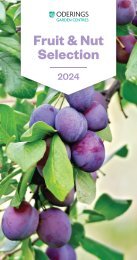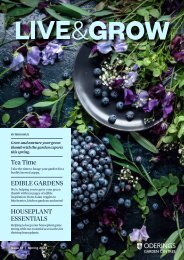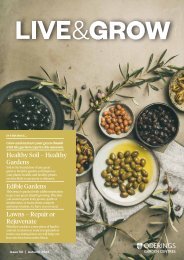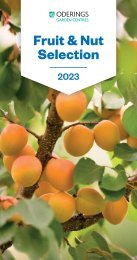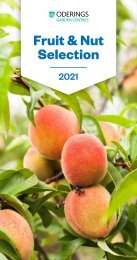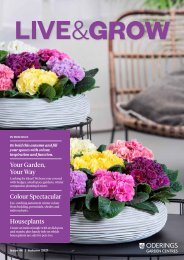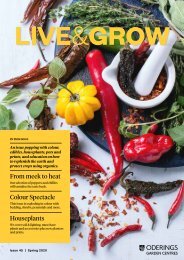Live & Grow Issue 49
Hot topics for gardeners and houseplant enthusiasts. Find out what plants, products and growing methods are best right now.
Hot topics for gardeners and houseplant enthusiasts. Find out what plants, products and growing methods are best right now.
Create successful ePaper yourself
Turn your PDF publications into a flip-book with our unique Google optimized e-Paper software.
IN THIS ISSUE<br />
All the tips, tricks and inspiration<br />
you need to help your garden<br />
‘spring’ to life, plus…<br />
New Zealand Natives<br />
Use natives to create a minimal<br />
fuss, contemporary garden, which<br />
attracts native wildlife and bees.<br />
Water Saving Gardens<br />
Steps you can achieve to ensure efficient<br />
water use in your garden.<br />
Edible Gardens<br />
Whether you are starting a veggie patch<br />
from scratch or want to try your green<br />
thumbs on a new crop, this issue is packed<br />
full of edible inspiration.<br />
<strong>Issue</strong> <strong>49</strong> | Spring 2022
Spring 2022<br />
What’s inside<br />
22<br />
4<br />
Oderings-<strong>Grow</strong>n<br />
Bedding<br />
New season's plants from the<br />
Oderings Wholesale team.<br />
5<br />
6<br />
7<br />
8<br />
9<br />
10<br />
12<br />
Oderings-<strong>Grow</strong>n Foliage<br />
Our selection of the best plants for<br />
adding contrast and texture using<br />
foliage.<br />
<strong>Grow</strong>ing from Seed<br />
A cost-effective way to get your flower<br />
and veggie garden growing this spring.<br />
Family Tree Planting<br />
A space saving technique, where 3-5<br />
trees are planted into the same hole.<br />
Codling Moth Breakthrough<br />
Control Codling Moth in the home<br />
garden the natural way.<br />
Humates – What are They?<br />
Humate is a pure form of organic<br />
matter and is essential to the life of<br />
the soil.<br />
Tomatoes – All you need<br />
for a tasty harvest<br />
Homegrown tomatoes taste better; we<br />
are here to help you grow a flavourpacked<br />
crop.<br />
<strong>Grow</strong> Corn, Eggplants and<br />
Cucurbits<br />
With some know-how, we will ensure<br />
you grow the best crop possible.<br />
14<br />
16<br />
19<br />
20<br />
22<br />
23<br />
24<br />
25<br />
Capsicums and Chillies<br />
Bringing you the pepper family<br />
champions for 2022.<br />
Creating a New Veggie Patch<br />
If you're considering starting a veggie<br />
garden, there are many options,<br />
depending on your space.<br />
Foodscaping with Pots<br />
and Planters<br />
Create an edible landscape rather than a<br />
traditional veggie garden.<br />
Houseplants - Classics<br />
and Cuties<br />
Exciting and unique foliage décor plants<br />
for this season.<br />
Peace Lily - The Bold and the<br />
Beautiful<br />
With so many different varieties, it may be<br />
time to expand your collection.<br />
Dirty Work made Delightful<br />
We caught up with the Plant Runner cofounders<br />
to learn more about this new<br />
product.<br />
Houseplant Must-haves<br />
Our top accessories to keep your<br />
houseplant game strong.<br />
Foliage Impact - Wall Hangers<br />
Houseplant walls make an incredible<br />
impact and are a great use of wall space.<br />
26<br />
27<br />
28<br />
30<br />
32<br />
34<br />
Pamper Your Plants this Spring<br />
New to Oderings, check out the power of<br />
hydrogen peroxide for your houseplants.<br />
<strong>Grow</strong> Poles<br />
You will love our new grow poles if you've<br />
got a houseplant with aerial roots.<br />
Baby Houseplant Collection<br />
We think we have the best selection of baby<br />
houseplants in New Zealand, with varying<br />
colours, textures and sizes.<br />
Oderings-<strong>Grow</strong>n Colour<br />
Our top choices for adding flower power to<br />
the garden and pots this season.<br />
Water-Saving in your Garden<br />
Things you can do to ensure efficient water<br />
use in your garden.<br />
The Contemporary NZ Native<br />
Garden<br />
Natives are minimal fuss; you can curate a<br />
contemporary look in your landscape while<br />
enjoying your space and not becoming a<br />
labourer in the garden.<br />
36 Ligularia<br />
A feature plant that has had a resurgence<br />
with its bold architectural form.<br />
38<br />
A Station for Bird Hydration<br />
Don't let bird baths and drinking stations be<br />
an afterthought.
Welcome Back<br />
Welcome to another issue of the Oderings <strong>Live</strong> & <strong>Grow</strong> Magazine. It's nice to<br />
see a bit of normalcy creeping back into our working lives. The workshops<br />
have been planned for spring, the special guest speakers are booked, and<br />
we are gearing up for what we hope is a busy spring season. We are also<br />
super excited about all the awesome new plants that our Oderings Wholesale<br />
teams have planned for this year.<br />
You may remember from our last issue the work we have been doing<br />
around consolidating our Oderings Wholesale operation in Hawke's Bay. We<br />
are excited to announce that we have now built our very own quarantine<br />
facility. Over the next few years (that's how long it takes to get new plants into<br />
circulation), you will see even more new introductions arriving in our stores.<br />
The lists of what are available have started to arrive, so it's a fascinating time.<br />
Watch this space!<br />
However, what isn't feeling exciting is the cost of living. In my family of four,<br />
our grocery bill has skyrocketed, and if we weren't growing so many of our<br />
vegetables, I can only imagine how much higher it would be. With this in<br />
mind, we have dedicated over one-third of this magazine to edibles. We have<br />
you covered with how to grow from seed, to starting a new veggie patch,<br />
foodscaping in pots, and family fruit tree planting. If you have ever wondered<br />
what you need to do to have a successful crop of summer fruiting tomatoes,<br />
courgettes, cucumbers and more, we have that covered too. If you don't find<br />
what you are looking for in the magazine, have a look at oderings.co.nz. We<br />
have a massive library of information to make gardening simple.<br />
Speaking of the website, we have moved click and collect into oderings.co.nz.<br />
Initially, during the lockdown, we did a quick fix to work with what we had,<br />
which was relatively limited and clunky. We are sure this new experience<br />
will be easy for you to navigate, and you will be able to find everything in the<br />
one space.<br />
Happy Gardening<br />
Pamela Smith<br />
Editor<br />
14<br />
Oderings<br />
<strong>Live</strong> & <strong>Grow</strong><br />
Editor Pamela Smith<br />
Advertising Nicola McKee<br />
Design Kimberley Turland<br />
Contributors Pamela Smith,<br />
Daniel Hart, Jenna Zanchettin, Hollie Tilbury<br />
Contact Us<br />
Oderings Garden Centres Head Office<br />
92 Stourbridge Street, Spreydon,<br />
Christchurch 8024<br />
PO Box 33125, Barrington<br />
Christchurch 8244<br />
P: 03 332 9099 F: 03 332 1585<br />
info@oderings.co.nz<br />
www.oderings.co.nz<br />
Store Locations<br />
Barrington 03 332 9099<br />
92 Stourbridge St, Christchurch<br />
Cashmere 03 338 5193<br />
205 Cashmere Rd, Christchurch<br />
Linwood 03 982 3<strong>49</strong>8<br />
485 Linwood Ave, Christchurch<br />
Philpotts 03 385 2386<br />
116 Philpotts Rd, Christchurch<br />
Yaldhurst 03 342 9198<br />
20 West Coast Rd, Christchurch<br />
Havelock North 06 877 3051<br />
57 Brookvale Rd<br />
Napier 06 844 8105<br />
11 Allen Rd, Pakowhai<br />
Palmerston North 06 356 6797<br />
136 Cook St, West End<br />
20<br />
© All content and images in this publication are subject to<br />
copyright and reproduction of any part is strictly prohibited.
ODERINGS-GROWN<br />
NEW<br />
Bedding<br />
Impatiens Lizzy Star Mixed<br />
We continue to re-introduce mildew and virus-free<br />
colours into our decimated NZ Impatient varieties.<br />
Welcome back to the improved Lizzy Star Mixed with<br />
its delightful shades of orange and red with white star<br />
shaped patterns.<br />
20-25cm<br />
20-25cm<br />
KEY<br />
Pot<br />
Size<br />
Pots/<br />
Planters<br />
Hanging<br />
Basket<br />
Garden<br />
Borders<br />
Gardens<br />
Primaflora<br />
Packs<br />
Packs<br />
Boxlots<br />
Attract<br />
Bees<br />
Part Shade/<br />
Shade<br />
Full Sun/<br />
Part Shade<br />
Height<br />
& Width<br />
NEW<br />
NEW<br />
Petunia Ramblin<br />
Sky Blue<br />
A unique early-flowering<br />
mounding and cascading<br />
Petunia, Sky Blue has<br />
unique colour tones and<br />
offers a tidy plant structure<br />
yet still fills the promise<br />
of easy, spreading colour!<br />
Available mid-October<br />
Petunia Ramblin<br />
Pink Cosmo<br />
High-performance,<br />
producing masses of<br />
veined, bright, deep-pink<br />
flowers that fade to lighter<br />
pink on the outer petals.<br />
With a spread of up to<br />
90cm, it will quickly cover<br />
a large area in the garden<br />
or pots.<br />
Petunia<br />
Blueberry Vein<br />
With a rich lavender base<br />
and dark veins radiating<br />
from its centre, this twotone<br />
beauty matches well<br />
with other darker colours.<br />
Fast-growing and a very<br />
versatile plant for your<br />
garden, pots or planters.<br />
Available mid-October.<br />
Petunia Silver<br />
Blue<br />
Silver blue outer petals<br />
deepen to a vibrant purple<br />
with even darker veins,<br />
making magnificent and<br />
impressive displays in mass<br />
plantings and gardens all<br />
season long. Available<br />
mid-November.<br />
30<br />
1.3L<br />
40<br />
1.3L<br />
30<br />
4<br />
40
ODERINGS-GROWN<br />
Foliage<br />
Lomandra Arctic Frost<br />
An attractive variegated evergreen<br />
grass-like perennial with narrow,<br />
dark blue-green leaves with<br />
contrasting white edges. The<br />
leaves are erect from the centre of<br />
the plant and then arch gracefully<br />
at the edges with maturity. A<br />
must-have for 2022!<br />
90cm<br />
90cm<br />
Oderings<br />
Exclusive<br />
NEW<br />
NEW<br />
NEW<br />
Phormium Purple<br />
Mountain<br />
A beautiful and easy-care plant<br />
with graceful, drooping, long purplechocolate<br />
coloured sword-shaped<br />
leaves. A great texture and contrast in<br />
pots and landscaping projects. Native<br />
birds and bees love the long flower<br />
spikes.<br />
Heuchera Sweet Tart<br />
Sweet Tart is from the Little Cuties<br />
series. Although small in stature, the<br />
tangy, lime-coloured foliage with<br />
fantastic bi-coloured cerise and<br />
hot-pink flowers from spring to<br />
autumn are a total standout.<br />
Available mid-November.<br />
Coleus Ruby Heart<br />
The thin, chartreuse border on heartshaped<br />
leaves continues on the<br />
undersides and stems, adding a bright<br />
glow. Showstopping colour, bold patterns,<br />
rich textures, and incredible performance<br />
in sunny gardens and patio planters.<br />
Ruby Heart will grow just as well in the<br />
shade, but avoid wet feet.<br />
Available mid-November.<br />
1.5m<br />
1.5m<br />
13cm<br />
20cm<br />
50cm<br />
50cm
<strong>Grow</strong>ing from Seed<br />
If you are looking for a cost-effective way to<br />
get your garden growing this spring, have you<br />
thought about growing from seed? You can<br />
get thousands of seeds for just a few dollars,<br />
and when growing from seed, you have the<br />
freedom to grow it your way, whether organic,<br />
hydroponic, in pots or direct in the garden.<br />
Spring is the busiest season in the garden, and<br />
you can sow a massive range of vegetables,<br />
herbs and flowers from Mr Fothergill’s quality<br />
range of packet seeds.<br />
<strong>Grow</strong>ing from seed is as simple as having sunlight,<br />
water, and soil. If you are new to growing from<br />
seed, start with some of the easier varieties and<br />
expand as you go.<br />
GARDEN SOIL PREPARATION<br />
Did you know that sowing seed directly into the<br />
garden eliminates transplant shock? This means<br />
that seed-grown plants quickly catch up to<br />
seedlings because they don’t experience a stall in<br />
growth from the root disturbance and change in<br />
conditions.<br />
Dig over your soil to the depth of your spade,<br />
removing weeds and debris as you go.<br />
Improve the soil by adding compost or well-rotted<br />
manure.<br />
Make a furrow about 15cm deep, sprinkle a little<br />
fertiliser into the base, and then refill the soil to<br />
almost the original level. Firm down and water well.<br />
SOWING<br />
The ideal sowing depth is about twice the diameter<br />
of the seed.<br />
Sow seeds along your furrow at the desired/<br />
recommended spacing.<br />
Cover your seeds with fine soil or seed-raising mix.<br />
Make sure to label your seeds and keep an eye out<br />
for the new sprouts as they emerge.<br />
CARE<br />
Keep soil moist (not wet) until seeds start to<br />
germinate. Ideally, cover the seeds with clear plastic<br />
or glass to help keep the humidity and heat just<br />
right for them to germinate.<br />
Thin out newly emerged seedlings at the twoleaf<br />
stage to prevent overcrowding, leaving the<br />
strongest plants to mature.<br />
Apply a liquid fertiliser at regular intervals (starting<br />
with a half dose on young plants) to encourage<br />
strong and vigorous growth.<br />
TIPS<br />
Always choose a sunny position for your garden bed.<br />
Seeds will not germinate unless the soil<br />
temperature is adequate for that variety.<br />
All of Mr Fothergill’s seed packets have detailed<br />
growing instructions specific to each variety on the<br />
back of the packet. Always follow these guides for<br />
the best chance of success.<br />
Check each packet for detailed advice on when to sow for your area. You can learn more about growing from<br />
seed and what to plant each season by visiting www.mrfothergills.co.nz.<br />
6
Family Tree Planting<br />
MULTIPLE TREES IN ONE HOLE<br />
One of Oderings’ fruit tree suppliers, Waimea Nurseries, showed us family tree plantings several years<br />
back. Family tree planting is where 3-5 trees are planted into the same hole, and without looking closely,<br />
the trees appear to be one. Family tree plantings mean that fruit will be harvested over a longer period<br />
with several varieties, rather than a glut over a week or two, while only taking up the space of one tree.<br />
HOW TO CREATE A FAMILY TREE PLANTING:<br />
1. Select three to five varieties of the same fruit<br />
type, as these will have the same growth habit<br />
(peaches and nectarines can be combined as<br />
the trees are identical).<br />
2. Prune each tree to have branches facing out<br />
on one side, with branches starting at around<br />
the same height on each tree. This might<br />
seem to create an unbalanced, weak tree with<br />
the weight all on one side, but these will be<br />
counterbalanced by the roots growing together<br />
with those from the other trees to create a solid<br />
anchor.<br />
6. Tidy up with further pruning to ensure no<br />
branches are crossing or growing into each<br />
other.<br />
TIPS:<br />
Don’t use dwarf varieties<br />
Make sure all trees are on the same<br />
rootstock, so the roots grow together and<br />
have the same tree vigour.<br />
Choose varieties that are either self-fertile or<br />
that will cross-pollinate each other.<br />
3. Dig a large hole, about 1m wide and 40-50cm<br />
deep.<br />
4. Arrange the trees in a circle within the hole,<br />
leaving a gap of 30cm between the trunks of<br />
each tree, with all branches facing outwards.<br />
5. Return the soil to the planting hole, pressing<br />
down to ensure the soil is firm but not<br />
compacted. Mix in compost to enrich poor soil if<br />
necessary.<br />
To watch a video on how to do a family tree planting, visit Waimeanurseries.co.nz<br />
RECOMMENDED VARIETY COMBINATIONS:<br />
Varieties are listed in order of maturity, with the<br />
approximate harvest range noted:<br />
Plums: December to March<br />
Plumcot Scarlet Sunrise, Satsuma, Lucy, Omega.<br />
Apricots: December to February<br />
Katycot, Tomcot, Trevatt, Cluthalate.<br />
Peaches: December to March<br />
Dixired, Coconut Ice, Flatto Sweet Cap, Blackboy.<br />
Peach/Nectarine combo: December to March<br />
Nectarine Early Red II, Peach Coconut Ice, Flatto,<br />
Nectarine Button Bright, Peach Blackboy.<br />
Apples: February to May<br />
Initial, Ariane, Adore, Granny Smith.<br />
Pears: January to May<br />
Starkcrimson, Packhams Triumph, Taylors Gold,<br />
Winter Cole.<br />
Note: Not all varieties listed are stocked by Oderings<br />
Nectarines: December to March<br />
Early Red II, Goldmine, Flatto, Button Bright,<br />
Red Gold.<br />
7
Codling Moth Breakthrough<br />
Control Codling Moth your Home Garden<br />
or small Orchard the Natural Way.<br />
Madex 3 has been used in commercial apple and<br />
pear orchards for codling moth control for over<br />
20 years. It is an organic product based on a live<br />
organism - the codling moth granulosis virus,<br />
otherwise known as CpGV.<br />
In 2019 a new product called Madex 2 was<br />
launched into the home garden market. Madex 2<br />
is a diluted form of Madex 3, specially formulated<br />
for small orchards and home gardeners. It<br />
controls codling moth caterpillars in their earliest<br />
juvenile stages before they begin to burrow into<br />
the fruit. Once caterpillars have burrowed deep<br />
within the fruit, they become impossible to control;<br />
therefore, an early application provides the best<br />
results. Madex 2 will not control adult moths.<br />
Madex 2 is an organic insecticide and is Bio-Gro<br />
certified. Madex 2 should be used in conjunction<br />
with NoPests codling moth pheromone traps.<br />
The No Pests codling moth pheromone trap is<br />
an effective control device for adult male moths<br />
preparing to mate. It is also a monitoring device<br />
for potential infestations when used early in the<br />
season. Start spraying with Madex 2 seven days<br />
after the first moths are caught in the traps. This<br />
will usually be in the last week of September<br />
or early October. Repeat applications at 7-to-<br />
10-day intervals until mid-December. A second<br />
infestation of young caterpillars may also occur<br />
in mid-January. When the codling moth trap<br />
pheromone lure expires after about six weeks of<br />
use, a refill pack can be purchased without buying<br />
a completely new trap.<br />
Madex 2 is entirely safe for bees, but ensure your<br />
sprayer has been decontaminated and well rinsed<br />
out before spraying apples in bloom. Spray residue<br />
from prior use of other insecticides could kill bees.<br />
Madex is also safe for pets such as cats, dogs and<br />
poultry that might wander into the spray zone<br />
around trees.<br />
Storage<br />
Madex 2 contains live viruses and, therefore,<br />
should be stored in a fridge in the original closed<br />
container at less than 5°C. If not refrigerated,<br />
Madex 2 should be stored in a cool, dry place out<br />
of direct sunlight and used within 28 days.<br />
Madex 2 is a very stable product, so the activity<br />
of the virus will not be reduced if the product is<br />
shipped without refrigeration (up to a maximum<br />
average temperature of 25°C). However, once the<br />
spray solution has been made up, the Madex 2<br />
concentrate should be re-chilled in the fridge, to<br />
ensure it does not lose its potency. When stored<br />
appropriately at 5°C or less, this product should<br />
last 22 months from the date of manufacture.<br />
TIP: Remember to treat ornamental crab apple<br />
trees as well as your fruit trees, as these may<br />
be a source of codling moth infestation.
Humates – What are They?<br />
Humate is a pure form of organic matter. It is<br />
an accumulation of partially decayed forest and<br />
other carbon-rich plant residues that have been<br />
compressed and preserved over the ages. These<br />
humate deposits are high in carbon, natural<br />
minerals and trace elements and are referred<br />
to as humic substances. Humates also contain<br />
two potent bioactive substances, humic acid and<br />
fulvic acid. Southern Humates are sourced from<br />
a site in the deep south of New Zealand, have<br />
high levels of humic acid (40-48%) and high levels<br />
of carbon (up to 60%), and are also BioGro NZ<br />
certified.<br />
Humic acid is essential to the life of the soil, and<br />
it is present in the organic matter that feeds<br />
plants as well as bacteria, fungi and nematodes,<br />
all of which provide food for larger soil organisms<br />
further up the food chain. This is the important<br />
process we know as nutrient cycling and is what<br />
provides the nutrients in the soil to feed our plants.<br />
To aid overall plant health and provide natural<br />
protection against plant pests with humates, look<br />
out for any of these products at Oderings.<br />
Organic Humate - Contains two very powerful<br />
bioactive acids: humic and fulvic acid. The<br />
carbon in humate is a form of carbohydrate that<br />
feeds the fungi and bacteria in the soil, creating<br />
biological diversity.<br />
<strong>Grow</strong>th Booster – The blend of sheep pellets and<br />
20% humate, makes the pellets easier and quicker<br />
to break down and have the carbon available to<br />
feed the microbes.<br />
Turbo Blend – A blend of worm castings,<br />
Southern Humates and trace elements, offering<br />
a wide range of benefits, including boosting the<br />
potential of the soil, improving soil structure, and<br />
promoting root growth and nutrient absorption.<br />
9
Tomatoes<br />
ALL YOU NEED FOR A TASTY HARVEST
Tomatoes seem to be one of those things in<br />
life that people either love or hate, but one<br />
thing remains true: homegrown tomatoes<br />
taste better. Getting a flavour-packed tomato<br />
takes more than just the right variety. When<br />
you use the right product, even a sweet or<br />
acid-free variety of tomato is enhanced.<br />
Generally, I plant 'Mega Tom' grafted tomatoes.<br />
These are created by merging two different<br />
varieties of tomato plants, the rootstock and scion.<br />
The rootstock provides strength, while the scion<br />
produces beautiful, tasty fruit. A grafted plant can<br />
produce at least double the yield of a normal seedgrown<br />
variety. Because of the strong rootstock,<br />
'Mega Toms' have greater disease resistance;<br />
therefore, minimal spraying is required.<br />
HOW TO GROW<br />
Temperature: The optimum temperature for<br />
tomatoes is 18–22°C. They dislike temperatures<br />
below 10°C but can handle an occasional 5°C.<br />
Tomatoes are sun-loving plants. If your tomatoes<br />
are not ripening, it is most likely caused by low light<br />
levels.<br />
Soil and staking: Plant in Oderings Fruit & Veggie<br />
Mix. This will make watering more manageable<br />
and help keep diseases and weeds to a minimum.<br />
Remember to add a bamboo stake at planting time<br />
to support your plants. If you insert a stake beside a<br />
mature plant later, you could damage the roots.<br />
Feeding: The Fruit & Veggie Mix will give the<br />
tomatoes all the nutrients they need until they are<br />
one metre tall or start fruiting, then start using a<br />
tomato fertiliser. Plants in pots, when compared<br />
to plants in the garden, need different fertiliser, so<br />
come and see us for what's right for you.<br />
Watering: Water directly onto the soil, not the<br />
leaves, which can encourage disease. Adding a<br />
layer of mulch will help conserve moisture and<br />
suppress weeds. Never keep plants wet, but water<br />
regularly to encourage firm fruit.<br />
Removing laterals: Too many shoots inhibit fruit<br />
development; therefore, laterals must be removed<br />
regularly as the plant grows. Pinch the tips out<br />
once the tomato is 1.8m tall or at the top of your<br />
stake/greenhouse.<br />
How to get tastier fruit: Where you plant matters,<br />
and the more sun you can give your tomatoes, with<br />
direct UV rays, the better and sweeter they will<br />
taste. Water is also essential but maybe not in the<br />
way you think. Overwatering, especially at harvest<br />
time, will reduce the flavour. We recommend<br />
adding mulch to keep a consistent soil temperature<br />
and then giving the plants (on the roots, not the<br />
foliage) a deep water every 2-3 days in the heat of<br />
summer; if planted in pots or glasshouses, water a<br />
little more often. And lastly, seaweed-based plant<br />
tonics also yield better-flavoured fruit.<br />
When to harvest: While colour is the best<br />
indicator, so is the feel. An unripe tomato is firm<br />
to the touch, whereas an overripe one is squishy.<br />
A ripe tomato should be firm, but when lightly<br />
squeezed/pressed, it will have a little give to it.<br />
Many people like to vine ripen tomatoes. This<br />
means you wait until they have full colour on the<br />
vine before picking. Equally there are people who<br />
like to ripen their fruit once picked. The colour<br />
should have little to no green and more pink than<br />
red in order to ripen the fruit off the vine.<br />
TOP VARIETIES 2022<br />
Basket – Tumbling Tom<br />
Patio – Russian Red or Big Boss.<br />
Cocktail Fruit – Sweet 100's, Sweet Treats<br />
or Grapevine.<br />
Medium Fruit – Potentate, Money Maker,<br />
Grosse Lisse or Early Girl.<br />
Large Fruit – Big Beef or Big Boss.<br />
Acid-Free – Roma.<br />
Oderings Favourite – Sweet Treats,<br />
Grapevine and Big Boss.<br />
To help you choose the right tomato for<br />
you, we have all the varieties listed at<br />
oderings.co.nz.<br />
NEW TOMATO<br />
Tomato Sun Dipper - We love the concept<br />
that Sun Dipper's elongated fruit can be held<br />
between your fingers for easy use with dips<br />
and sauces, and that the orange fruit looks<br />
excellent on a vegetable platter and tastes<br />
delicious. This durable plant has excellent<br />
disease resistance and produces heavy yields.<br />
Available mid-October.<br />
Tomato Sun Dipper<br />
Oderings<br />
Exclusive<br />
11
<strong>Grow</strong> Corn,<br />
Eggplants<br />
and Cucurbits<br />
12<br />
Corn, eggplants and cucurbits are some of<br />
the trickiest veggies to grow. But with some<br />
know-how, we will ensure you get the best crop<br />
possible. There are several things these families<br />
of plants have in common that are essential for<br />
getting them to grow strong and healthy.<br />
Frost - all are extremely frost tender and coldsensitive.<br />
Ideally, wait until late October before<br />
planting outside, and unless your glasshouse is<br />
heated, early to mid-October is ideal.<br />
Wind - a big killer for them all, especially cucurbits<br />
and eggplants. If you must plant in a high wind zone,<br />
plant later in the season and surround the plants<br />
with a windbreak to protect them.<br />
Water - not too much, especially when the plants<br />
are young, as they will rot and die. Only water when<br />
dry. As any fruit develops, increase your watering<br />
slightly to help the fruit swell, but then reduce again<br />
at harvest to help keep it more flavoursome.<br />
Temperature - they all need heat to flourish, and<br />
the optimum temperature needs to be over 18°C<br />
and get no lower at night than 8°C. In a lot of NZ,<br />
this is hard to maintain. Using Mikroclima to create<br />
an insulated area is ideal in these cases.<br />
Sunlight - Plant in an area with at least six hours<br />
of sunlight. If you don't have a spot in the garden that<br />
will provide six hours’ of light, consider pots (for all<br />
except corn) and move them around to follow the<br />
sun.<br />
Soil - Incorporate plenty of compost and sheep<br />
pellets at planting to replenish the garden, or use<br />
Oderings Fruit & Veggie Mix in pots. The soil needs to<br />
be well-drained for success.<br />
CORN - Corn likes to be planted in blocks of ideally<br />
3x3 plants or more. Don't plant in a single long row or<br />
sporadically throughout the garden; the blocks are<br />
essential to help with pollination. Because they grow<br />
so tall, they may need staking in high wind areas<br />
as the plants grow. Corn only takes 3-4 months to<br />
produce, so don't plant in cold areas until November.<br />
You can tell when corn is ready to harvest because<br />
the ears, which are held tightly to the plant's stem<br />
as it grows, will start to move away from the stem.<br />
When it is at a 45° angle, it should be ready. Corn<br />
needs to ripen on the plant, so don't harvest too early.<br />
EGGPLANT - The better the soil, the better they will<br />
grow. Eggplants (aubergines) need a lot of sun and a<br />
long, hot summer to produce. They take around three<br />
months to produce, and in cold areas shouldn't be
planted until November. They also detest too much<br />
water. I find planting in black PB bags gives the best<br />
results because it keeps the roots of the plants nice<br />
and warm, and you can place them in the warmest<br />
area of your garden or patio. I always get a crop<br />
when planted in PB bags, even in Christchurch.<br />
CUCURBITS - Cucurbits are what we know as<br />
cucumbers and gherkins, pumpkins and squash,<br />
watermelons and rockmelons, zucchini/courgettes/<br />
marrow, and more. The main thing you need to<br />
succeed is to plant as late in the season as possible.<br />
November is usually the ideal time. Cucurbits will<br />
turn up their toes in strong or cold winds, with too<br />
much water and in response to even the slightest<br />
frost. Cucurbit fruit contains a lot of moisture, so<br />
it's no surprise they need water to help the fruit<br />
swell in size. Cucumbers, for example, contain up<br />
to 80% water, so if you are getting a poor crop,<br />
underwatering is likely the cause. Mulching around<br />
the plant is important to stop fruit from lying on the<br />
ground and rotting.<br />
CUCUMBERS & GHERKINS – By growing up a<br />
frame, you can increase the yield by 15-25%. If you<br />
don't harvest regularly, they will stop producing, so<br />
you must keep picking even if you don't eat them.<br />
PUMPKINS & SQUASH - Unless you are getting a<br />
small growing (1m wide) variety, pumpkins need a<br />
good 3-4m space between plants, and squash need<br />
1.5-2m. Don't harvest until the pumpkin is fully hard<br />
and the skin has reached its full colour.<br />
WATERMELON & ROCKMELONS - It needs to be<br />
warm to grow these, which is challenging in most<br />
NZ climates. Plant close to a North-facing wall and<br />
cover the root zone in black polythene, which helps<br />
keep the soil around the roots warm. You can tell if<br />
a melon is ripe by knocking on the fruit and getting<br />
a hollow sound; however, the best way to tell is if the<br />
part resting on the ground is now yellow. If the rest<br />
of the fruit has colour, it should be ready.<br />
ZUCCHINI/COURGETTES/MARROW – These are<br />
all the same plants. Zucchini/courgettes are picked<br />
early, and marrow is the same fruit left to mature<br />
longer. Often this can occur within days, so if you<br />
don't want marrows, check your plants regularly.<br />
Each plant needs a space of 80cm to 1m. Did you<br />
know courgettes have male and female flowers? If<br />
you find you aren't getting any crops, you may need<br />
to get a paintbrush to cross-pollinate the flowers,<br />
but hopefully, if you have a bee-friendly garden you<br />
won't have any issues.<br />
13
Capsicums<br />
and Chillies<br />
You will find our vegetable section brimming with capsicums and chillies<br />
this spring and summer. Our growing department in Christchurch has<br />
been trialling and tasting new ranges for the past few years to bring you<br />
the pepper family champions.<br />
GROWING AND LOCATION:<br />
When planting, use Oderings Shrub<br />
& Tub Mix, and feed with Total<br />
Replenish. Capsicums and chillies<br />
are fond of pots with a volume of at<br />
least 15 litres to get their root systems<br />
warmed up. If you choose to plant<br />
directly into the garden, make sure<br />
they are not too wet and keep them<br />
weed-free.<br />
When planting early in the season, be<br />
aware of frosts and, where possible,<br />
place the plant against the house<br />
facing full north. Make a cloche with<br />
stakes and Mikroclima; this material<br />
can be removed later once frosts<br />
have passed, and it helps to protect<br />
from strong, cold winds. This is<br />
important to intensify the heat for<br />
the hottest chillies if you want the<br />
maximum scoville rating.<br />
WATERING & CROWN BUD:<br />
Initially, try to keep plants from getting<br />
too wet. As the days get hotter, more<br />
water will be required, especially when<br />
the fruits begin swelling. As your plant<br />
grows into a bush, the<br />
growth will create a<br />
fork shape; this is<br />
where the crown<br />
flower (first flower)<br />
will form. If these<br />
first flowers are<br />
not removed, they<br />
will stunt your plant’s<br />
growth as the plant then<br />
puts all its energy into that one fruit.<br />
PESTS & DISEASES:<br />
Prevention is key. Upon planting, apply<br />
neem granules around the plant base<br />
and reapply every 4-6 weeks for a safe<br />
pest deterrent. If insects are present,<br />
use a pyrethrum-based spray.<br />
14
Oderings Chilli Selection 2022<br />
1. Jalapeňo Scorcher<br />
Loved by many, is easily eaten<br />
and classed as a mild heat.<br />
5. Habanero Red<br />
A popular building block in<br />
hot sauces.<br />
1<br />
2<br />
2. Longhorn<br />
Is a long red cayenne chilli<br />
of 15-25cm with a distinctive<br />
curl at the end. The plants can<br />
grow tall and need a stake to<br />
support all the fruit.<br />
3. Hot Red<br />
A type of cayenne pepper. It<br />
is a good starter if your heat<br />
resistance has surpassed<br />
the chillies often found in<br />
supermarkets. These are hot<br />
enough to give you a little kick<br />
with a heat that rolls over the<br />
tongue.<br />
6. Trinidad Scorpion<br />
A chilli pepper native to the<br />
village of Moruga in the<br />
Caribbean, which has a<br />
sweet-hot fruity-like flavour.<br />
Don’t be fooled by this,<br />
though; it held the record for<br />
the hottest pepper at one<br />
point.<br />
7. Carolina Reaper<br />
Eater beware; this is our<br />
hottest chilli and is not for<br />
the faint-hearted as it is<br />
incredibly hot, although it<br />
is initially sweet.<br />
3<br />
4<br />
5 6<br />
4. Ghost Pepper<br />
Known as the bhut jolokia or<br />
ghost pepper, adds spice to<br />
curries, pickles, and chutneys.<br />
7<br />
SCOVILLE RATING<br />
MILD<br />
MEDIUM<br />
HOT<br />
FIRE<br />
Oderings Capsicums<br />
1<br />
2<br />
1. Jumbo - is the most<br />
noteworthy bell pepper<br />
we have seen, with<br />
vigorous growth and<br />
a sensational flavour.<br />
A stake is needed to<br />
hold the weight of the<br />
substantial growing fruits.<br />
2. Lunchbox Series -<br />
available in red, orange,<br />
and yellow. The fruit is a<br />
perfect size to snack on<br />
straight from the bush<br />
or pop into the lunchbox,<br />
and has minimal seeds.<br />
The more you pick, the<br />
more fruit you will get.<br />
3. Ma Belle - this is<br />
our most popular, bellshaped<br />
capsicum. Ready<br />
when green but keep<br />
longer on the plant for<br />
fruit to ripen further to<br />
red.<br />
4. Tequila Series - the<br />
Tequila series comes in<br />
Orange and Yellow. The<br />
fruit is brightly coloured,<br />
bell-shaped, with a sweet<br />
flavour.<br />
5. Sweet Banana -<br />
named because of its<br />
sweet, elongated yellow<br />
fruit.<br />
3<br />
4 5<br />
15
16
Creating a New Veggie Patch<br />
If you're considering starting a veggie garden,<br />
there are many options, depending on your<br />
space. You could create a raised bed, section off<br />
an existing garden area, or even use vertical wall<br />
hangers. Whichever you choose, your veggie<br />
garden should be in a spot that gets plenty of<br />
sunlight. Around six hours a day is recommended<br />
for most veggie varieties, although plenty will<br />
grow with fewer sunshine hours.<br />
PLAN<br />
Start easy. List what you buy at the supermarket,<br />
and plant those veggies first, keeping in mind<br />
what's in season and suited to your local weather<br />
conditions. Lettuce, spinach and other leafy<br />
greens can be ready to eat in as little as 30 days<br />
and can be continually picked from as they keep<br />
growing. Brassicas such as your classic broccoli<br />
and cauliflower, and root crops like beetroot, take<br />
much longer, around 3-4 months before they are<br />
ready to harvest.<br />
Spacing is also important; if you are new to<br />
growing veggies, you may be surprised by how<br />
much space they can take up once they establish.<br />
Brassicas especially need to be planted 50cm<br />
to 70cm apart. Compact veggies like lettuce can<br />
be spaced 30cm to 40cm apart. Planting guides,<br />
such as the square foot gardening method, can<br />
give you more ideas on spacing while fitting in a<br />
wide range of veggies.<br />
SOIL AND PLANTING PREP<br />
Soil is an important consideration, and the trick<br />
to successful crops is to create quality soil for<br />
them to thrive in. Make sure the soil is loose and<br />
well-draining. One week before planting, turn<br />
the soil over with a spade or fork to ensure it is<br />
loose, aerated and free of weeds, then incorporate<br />
compost, blood & bone and/or sheep pellets.<br />
When planting brassicas, incorporating garden<br />
lime is essential: it can increase the yield by 50%<br />
and helps to avoid club root. Soil replenishment<br />
should happen each season when you are<br />
planting your next crop.<br />
While it may be tempting to plant out the veggie<br />
patch as soon as you get home with your goodies,<br />
wait until it's cooled down and plant around 5pm.<br />
When ready, make your holes double the width<br />
and depth of the veggie plant's root ball and pop<br />
your plant in, covering the root ball in soil. Always<br />
water in well by hand and use a seaweed tonic to<br />
minimise transplant shock. Always give another<br />
water after using seaweed if it hits the plant's<br />
leaves, as seaweed can stain the leaves of your<br />
plants.<br />
Also, never water at mid-day. First thing in the<br />
morning is best as this avoids the risk of burning<br />
the leaves and helps with water retention. Always<br />
try to water the soil and minimise water contact<br />
with the foliage, to prevent fungus diseases.<br />
WEEDS<br />
You've done all the hard work, so don't let those<br />
weeds pop up. A top tip in the garden is to make<br />
your rows twice as wide as your garden hoe.<br />
This way, you can run your garden hoe between<br />
the rows weekly and easily keep weeds at bay.<br />
Otherwise, using mulches such as pea straw or<br />
Besgrow Coir Mulch on the soil surface will keep<br />
weeds at bay and reduce how often you need to<br />
water, preventing up to 50% of normal water loss.<br />
UPKEEP<br />
As you watch your veggies grow, they will be<br />
using nutrients from the soil, so it is vital to replace<br />
these nutrients to ensure healthy and productive<br />
plants. Applying a liquid, vegetable-specific<br />
fertiliser such as Thrive Vegie & Herb Liquid Plant<br />
Food or a liquid blood and bone fertiliser like<br />
Nitrosol Original Liquid Fertiliser once a month will<br />
keep your veggies flourishing.<br />
PESTS<br />
Remember to check your plants for any pests and<br />
diseases. You may want to set up a crop cover for<br />
your veggie garden to protect against insects and<br />
birds. You can also use Debug for caterpillars and<br />
natural snail and slug protection.<br />
TIP: When your plants are going to seed, you will<br />
know because the foliage growth will become<br />
very vigorous, and flowers will appear (depending<br />
on the veggie). When this happens, you can leave<br />
the plants to provide food for the bees, or remove<br />
them. Although they may still be producing new<br />
growth, the leaves will often taste bitter.<br />
17
Foodscaping with<br />
Pots & Planters<br />
18<br />
Creating a meal from garden to table is a proud<br />
moment in our house. Christchurch is a much<br />
colder climate compared to the North Island,<br />
and since moving I've had to adapt to my new<br />
growing space over the past few years. Having<br />
always grown vegetables in garden beds, this<br />
took a bit of getting used to, but I have now<br />
conquered this by turning to foodscaping in pots<br />
and planters. I'm surprised how bountiful and<br />
easy edibles can be if you select the right plants<br />
for the right place with the right sized pot.<br />
What is foodscaping? It's the idea of creating an<br />
edible landscape in your garden space instead of<br />
just growing vegetables in the traditional veggie<br />
garden space. By incorporating pots and planters<br />
into your garden space, you can pack them full<br />
of vegetables, herbs, fruit trees, and companion<br />
plants, creating an edible landscape.<br />
Don't let renting hold you back. When renting, I<br />
grew edibles in pots on my tiny patio. My wallet<br />
also thanked me for it, and with the hike in food<br />
prices, it's a timely concept to delve into. <strong>Grow</strong>ing<br />
your edibles means you control what insecticides<br />
you use (if any), reduce waste in your fridge, share<br />
foods with friends and neighbours, and reduce<br />
your plastic waste.<br />
30-50 DAY EDIBLES<br />
If you're a first-time gardener, this list is for you<br />
as these plants are quick-producing and minimal<br />
work. You can also try mixing and matching these<br />
plants into an Elho Green Basics 38cm Bowl.<br />
Lettuce: Lettuce Gourmet Oak is ideal for picking<br />
and growing again. You don't need to allow this<br />
lettuce to heart up. Three plants per bowl.<br />
Bok Choy: Pak Choi/Bok Choi is a fast-growing<br />
vegetable with an interesting mild flavour in stirfries.<br />
Harvest the entire plant for your meals. This<br />
plant is upright, so you can fit many into your<br />
planters. Five plants per bowl.<br />
Baby Spinach: Dark green leaves with a fast<br />
growth habit. Pick early and often to minimise the<br />
plant going to seed. Baby spinach plants will grow<br />
15cm and don't mind cramming into a pot. Full sun<br />
is required. Three plants per bowl.<br />
Radish: <strong>Grow</strong> radishes from seed and plant a lot.<br />
Radishes can also be planted in between longerterm<br />
veggies such as brassicas. Sow seeds thinly<br />
at 1.5cm deep. 20 seeds per bowl.<br />
Spring onions: Spring onions can be planted from<br />
seed or transferred from seedling punnets into a<br />
pot. Another vegetable you can plant en masse and<br />
harvest when required. Use 20 plants per bowl.<br />
Herbs: Ideal to add to your bowls or to mix and<br />
match with other plants in this 30-50 day selection.<br />
Plant three to five per bowl and harvest regularly.<br />
Minature Beans: Baby beans are just little, but you<br />
will be able to get a few handfuls each week when<br />
they are at their peak. Pick when young and keep<br />
the plants out of the wind. Three to five plants per<br />
bowl.<br />
INCORPORATE STAKES AND CAGES IN POTS<br />
Elevate your growth upwards and make the most<br />
of your space. We grow a range of smaller edibles<br />
that will keep providing all summer long; you just<br />
have to keep picking. All you need is an Elho Green<br />
Basics 30cm pot, a 1.5m bamboo stake and soft<br />
ties. You can make a cage out of three stakes or<br />
stake the plants up one. Cucumber (Lebanese and<br />
Gherkin), and tomatoes (Russian Red, Sweet treat<br />
and Totem) are all ideal. Keep these plants out of<br />
the wind.<br />
EDIBLES IN HANGING BASKETS<br />
Tumbling Tom tomatoes, and strawberry plants,<br />
are great options if you have space under your<br />
eaves or want to install brackets onto your fence<br />
and suspend edibles from there. You only need one<br />
Tumbling Tom tomato per 30cm coir basket and<br />
three strawberries per basket.
FRUIT IN POTS<br />
Fruit in pots look gorgeous when incorporated into<br />
your landscaping. Standardised citrus is great for<br />
colour in winter when your plants are laden with<br />
fruit. Try underplanting with cascading rosemary<br />
or thyme. Blueberries and NZ cranberries grow<br />
well in pots and are a great option to encourage<br />
kids into the garden. Columnar apples like<br />
Ballerina Polka and standard apples like Blush<br />
Babe are great space savers and hefty yielders.<br />
Standard nectarines and peaches offer beautiful<br />
flowers and excellent harvest potential. All these<br />
plants do well in large containers of at least<br />
80-120 litres.<br />
GROWING TIPS<br />
Soil: Do not use soil from your garden or straight<br />
compost from your home compost bin. Purchase<br />
a top quality container mix containing the blend<br />
of the right ingredients to get the most out of<br />
your vegetables. Oderings Shrub & Tub or Fruit &<br />
Veggie mix are ideal.<br />
Feeding: The soil you purchase is packed full<br />
of fertiliser. However, when growing in pots, the<br />
nutrients are used quickly compared to ground<br />
planting. You can supplement feed with Yates’<br />
liquid fertiliser range.<br />
Watering and hydration: Make sure you're<br />
watering regularly and have a hose on standby.<br />
If your pots are not watered well, the soil can<br />
become hydrophobic, so mulch is an excellent<br />
investment to lock the water in. Hydrated plants<br />
also minimise pests and help the fruit to swell!<br />
Besgrow Coir Mulch is great on top of the soil to<br />
retain hydration.<br />
19
Houseplants<br />
CLASSICS AND CUTIES<br />
2<br />
1<br />
20
1. Philodendron Hederaceum Brasil<br />
2. Ficus Benjamina Wintergreen<br />
3. Calico Kitten | Crassula Pellucida Variegata<br />
4. Ficus Benjamina Starlight<br />
5. Begonia Angel Wing<br />
6. Ctenanthe Burle Marxii<br />
4<br />
3<br />
6<br />
5<br />
21
Peace Lily<br />
THE BOLD AND THE BEAUTIFUL<br />
This is a timeless houseplant that many people own,<br />
but there are so many varieties you may catch yourself<br />
having one in each room. Peace Lilies are low-care,<br />
purify the air, promote a pleasant night’s sleep, and tell<br />
you when they need watering. What other plant can<br />
come back from near-death experiences?<br />
Sensation: Sensation<br />
can be hard to come<br />
by and is popular for its<br />
dark green leaves with<br />
matte, ribbed foliage.<br />
Most Peace Lilies have<br />
an upright growth habit,<br />
but Sensation leaves<br />
droop gracefully and<br />
can have a leaf span of<br />
up to 25cm.<br />
22<br />
Silvana: This Peace<br />
Lily is a good ‘first<br />
plant’ variety for people<br />
looking to start a<br />
houseplant collection.<br />
This variety has a dense<br />
growth habit that always<br />
looks full and constantly<br />
pumps out new, glossy<br />
growth.<br />
Bellissimo: One of the<br />
smallest Spathiphyllum,<br />
only growing to about<br />
45cm. Bellissimo is<br />
incredibly full in its<br />
growth. We grow this<br />
variety in Christchurch<br />
as it’s one of the best<br />
performers in cooler<br />
environments.<br />
Sebastiano: This king<br />
of all Spathiphyllum is<br />
the largest growing,<br />
with towering stems<br />
over 1m tall, with the<br />
flower growing even<br />
taller above the leaves:<br />
stunning!<br />
Photo credit @thejoyofplants
Dirty<br />
Work Made<br />
Delightful<br />
Plant Runner is new to Oderings. We caught<br />
up with Plant Runner co-founders Duncan<br />
Hilder and Dominic Hooghuis.<br />
According to a recent poll, there is a dead or dying<br />
plant in every office and house worldwide. Cause<br />
of death? Over-watered by an ugly watering can<br />
or dried out in a sad plastic pot.* Dom and Duncan<br />
decided to tackle this problem head-on and create<br />
plant care magic formulas that green things love.<br />
Their mission resulted in bespoke products that<br />
make it easier to keep plants alive and thriving.<br />
As a proud dad, Dom is passionate about growing<br />
a better future for the next generation and<br />
educating small hands about the beauty and<br />
pleasure of nature. Co-founder Duncan loves<br />
a good yarn about what you’ve got growing at<br />
home. We asked Duncan what inspired the duo<br />
to create Plant Runner. He said “While in New<br />
York, I visited a plant installation that immersed<br />
you in nature, in one of the most iconic concrete<br />
jungles of the world. After raving about it to Dom,<br />
he found us a truck within minutes. The following<br />
weekend we were the proud owners of a 1962<br />
Harvestor International horse float, and it took<br />
us six months to convert it into a fully functional,<br />
mobile plant shop known as The Plant Runner.”<br />
We asked Duncan how they went from selling<br />
plants off the back of a truck to supplying<br />
over 400 stores in New Zealand, Australia and<br />
worldwide.<br />
“After many conversations with our customers<br />
about plant care, we realised there was a need<br />
for indoor-focused plant care products. Using our<br />
shared background in horticulture, we launched<br />
our Indoor Plant Food, and things quickly grew<br />
from there.”<br />
They wouldn’t be very good plant people if they<br />
didn’t also do as much as they could to minimise<br />
their impact on the environment. While caring<br />
for your plants, Plant Runner also helps care for<br />
our planet. 1% of all sales are donated to 1% For<br />
The Planet, supporting environmental causes and<br />
organisations. They are also obsessively waste<br />
conscious, minimising plastic use and being as<br />
sustainable as possible.<br />
Plant Runner Indoor Plant Food is more than just<br />
fertiliser. It’s a superfood, providing plants with<br />
essential nitrogen, phosphorus, potassium, trace<br />
elements, and seaweed.<br />
Plant Runner Neem Oil Leaf Shine combines 100%<br />
certified organic neem seed, hand-blended with<br />
a vegetable-based wetting agent. Unlike most<br />
leaf shine products, it’s non-comedogenic, so it<br />
won’t block your plant’s ability to breathe and<br />
photosynthesise.<br />
Oderings is proud to stock Plant Runner in<br />
store and online, ready to support you in your<br />
plant parenthood journey, like a moss pole to a<br />
Monstera.<br />
*Poll conducted by Dom and Duncan, who asked their mothers. Both women agreed this would likely be the case.<br />
23
1 2 3<br />
4 5 5<br />
Houseplant must-haves<br />
Our top accessories to keep your houseplant game strong<br />
7<br />
6<br />
8<br />
1. Long Spouted Watering Can - Watering your plants in hard-to-reach areas is made easier with these watering cans.<br />
2. Watering Bottle - Water your cuttings or cacti with control and accuracy. 3. Clear Pots - Watch your plants grow<br />
and inspect their root systems. Two sizes available, 10cm high x 8.5cm wide or 7cm high x 7.8cm wide.<br />
4. Velcro Plant Tape - Is strong, reusable, inconspicuous, and doesn’t harm the precious stems of your plant. Cut the<br />
length you require and attach. 5m length x 10mm width. 5. Self-Watering Spikes - Two designs are available to water<br />
your pot plants slowly. 6. Plant Stands - Upgrade your houseplants into our contemporary plant stands, featuring timber<br />
detailing. 7. Houseplant <strong>Grow</strong>ing Frames - Miniature growing frames are 27cm tall and come in three different designs.<br />
Perfect for your slow growing treasures. 8.Waterproof Oxford Plant Mat - Repot your plants and contain any mess with<br />
this fold-away repotting mat. Size: 75cm x 75cm.
FOLIAGE<br />
IMPACT<br />
Wall hangers<br />
Houseplant walls make an incredible impact and<br />
are a great use of wall space. If you are short<br />
on room, your bench tops are at capacity, or<br />
you want to make an impact in your office, our<br />
custom, NZ-made wall hangers are ideal. They<br />
are powder-coated to stand the test of time and<br />
are suitable for indoors and out.<br />
Install Tip: Select your area wisely. If installing into<br />
gib, assess your area first and speak to a guru in<br />
the hardware store about anchor nails and weight<br />
restrictions. Some anchor nails can hold up to 15kg.<br />
Plant Tip: When selecting your plants, assess whether<br />
the area is low light, medium light, or bright light then<br />
come in and let us help you select the right plants.<br />
IMPACT PLANT CHOICES:<br />
Oderings' favourite indoor plants:<br />
Boston Fern, Philodendron Cordatum,<br />
Philodendron Brasil, Tahitian Bridal<br />
Veil and Rhipsalis varieties.<br />
Oderings favourite outdoor plants:<br />
Bacopa, Pratia Angulata, Dichondra<br />
Silver Falls and herbs.<br />
Pot match:<br />
Lifestyle Cylinder 15cm and Lifestyle<br />
Tulip 14cm for indoors, and terracotta<br />
is ideal for outdoors.<br />
Plants featured: Philodendron Cordatum and<br />
Scindapsus Pictus.<br />
25
Pamper Your Plants<br />
this Spring with the<br />
TM<br />
Power of Oxygen Plus<br />
Have you noticed how lush your gardens look<br />
after it rains? Then you have already witnessed<br />
the power of hydrogen peroxide. Adding this<br />
unsung hero to your plant care regimen can<br />
mimic what Mother Nature does best. By using<br />
Oxygen Plus TM on your plants, they will flourish<br />
as never before.<br />
As spring approaches, your plants need care and<br />
prepping for the changing seasons ahead. Using<br />
H2O2, you can protect your plants from baddies<br />
and lavish them with love when you sanitise and<br />
invigorate their environment. Your leafy friends will<br />
flourish with the addition of extra oxygen, the key<br />
ingredient that will care for and clean your plant<br />
pals as nature intended.<br />
The magic is in the extra oxygen atom. This<br />
superstar is why Oxygen Plus readily biodegrades<br />
without any harmful residues and delivers<br />
essential oxygen directly into the roots to help<br />
boost your plant’s health. This busy fellow has a<br />
long list of abilities in protecting your botanical<br />
buddies: treating disease and pests and ensuring<br />
their home is germ-free and nutrient-rich.<br />
1. BAN THE BADDIES: When repotting or<br />
planting, try sanitising both the soil and<br />
your seeds with Oxygen Plus TM to create<br />
a nutrient-rich bed of soil that is pestfree<br />
and prevents potential root-rot and<br />
infections. If you spot some buggy hecklers,<br />
you can swiftly treat your plant’s pests with<br />
this too.<br />
2. HYDRATION STATION: Believe it or<br />
not, dying or dilapidated plants can get a<br />
significant boost from the added oxygen.<br />
Eliminate your plants’ limp foliage and<br />
lifeless “locks”, when tried and true O2 is<br />
released by the H2O2 molecule.<br />
3. LOVING THE LEAVES: When growing<br />
healthy plants, it’s imperative to look after<br />
their leaves. The leaves provide food and air<br />
to the whole plant’s system. Leaves pick up<br />
dust, and indoor plants usually need more<br />
moisture than they receive. We suggest<br />
spritzing your plants 1-2 times a week with<br />
a diluted 1:32 H2O2 water solution, paying<br />
particular attention to the dust build-up.<br />
While misting check for any rust-like<br />
colouring, white or brown spots in case<br />
of a fungal infection, and if any is present,<br />
you can easily flush the fungus away with<br />
Oxygen Plus TM hydrogen peroxide.<br />
26
<strong>Grow</strong> Poles<br />
If you’ve got a houseplant with aerial roots, you will love our new<br />
grow poles. What’s an aerial root, you may ask? Mother Nature<br />
made some plants with small nubs (aerial roots) on the vine or stem<br />
so they can attach themselves to tree trunks and climb their way up,<br />
towards the light. If you have an extensive houseplant collection, you<br />
will see these small, white nubs on your aroid-type plants.<br />
The benefit of using a grow pole is that the leaves of the attached<br />
plant tend to grow much larger than if you had it as a trailing plant.<br />
The moss in these grow poles is similar to a constantly hydrated tree<br />
trunk in the natural environment, and the internode gaps on the poles<br />
are smaller, creating a plant that is bushier in its growth. Also, the<br />
poles are a great space saver. Have we convinced you yet?<br />
YOU WILL NEED<br />
<strong>Grow</strong> pole<br />
Bamboo stake<br />
Filling – either hydrated sphagnum moss or fern fibre<br />
Velcro plant support tape<br />
A skewer<br />
Step 1: Connect the pole and insert a bamboo stake down the<br />
middle. The bamboo stake provides extra strength to the pole and is<br />
inserted into the soil. Make the length of the bamboo longer than the<br />
pole, long enough to be the same depth as your pot.<br />
Step 2: Push the bamboo stake into the soil and then place the pole<br />
over the bamboo stake. Push the grow pole down so 5cm is in the<br />
soil and press firmly around the base.<br />
Step 3: Insert filling into the pole gradually, using the skewer to lightly<br />
compact as you fill. The filling you use should never be soaking wet,<br />
only damp.<br />
Step 4: Make a hole in the soil and plant your desired houseplant.<br />
Use velcro support tape to connect the plant to the pole. The velcro<br />
can be removed as soon as the roots take hold.<br />
Suitable plants: Epipremnum types, Philodendron Minima and<br />
Micans, Philodendron Pink Princess, Syngonium and Monstera<br />
Standleyana are suitable plants, to name a few.<br />
Maintenance: Mist your plant as required and keep the filling<br />
hydrated by pouring water directly into the pole. Never allow the<br />
filling to dry out completely. Water the soil as you would normally.<br />
MADE WITH<br />
RECYCLED PLASTICS<br />
MADE WITH<br />
OWN WIND ENEGRY<br />
100%<br />
RECYCLABLE<br />
MADE IN HOLLAND<br />
27
1<br />
2<br />
3<br />
Baby Houseplant Collection<br />
We have a vast selection in our baby houseplant range, from foliage to succulents,<br />
and we’re adding to the range often. Baby houseplants are a low-cost option to<br />
increase your collection, and babies are ideal for making terrariums, kokedama, or<br />
simply growing on to create big, bushy plants.<br />
4<br />
5 6<br />
7<br />
8<br />
9<br />
28
1. Begonia Black Star<br />
An attractive begonia with bold, green foliage,<br />
darkening to black-purple when mature. The<br />
patterns vary on each textured leaf. Begonias like to<br />
be misted to encourage luscious leaves, and they<br />
enjoy free draining soil. A fabulous side table plant.<br />
Watering: Never allow the soil to completely dry<br />
out and keep it evenly watered.<br />
30cm<br />
30cm<br />
2. Peperomia Parallel | Peperomia Puteolata<br />
This peperomia is quirky in its growing habit, with<br />
sprawling long stems and large internode spacing.<br />
The leaves are beautifully thick, with white stripes,<br />
like watermelon skin. Pinch out to promote dense<br />
growth or leave to its own devices.<br />
Water: Peperomia are prone to root rot, and it<br />
is safer to underwater than overwater. Treat this<br />
peperomia like a succulent. It is evident when you<br />
have overwatered because you will see sudden leaf<br />
drop.<br />
30cm<br />
3. Alternanthera Ficoidea ‘Partytime’<br />
Partytime is a new baby houseplant addition<br />
for Oderings, and it is as cute as a button. This<br />
Alternanthera features a variegated pink and green<br />
leaf and performs best by pinching out the tips.<br />
Water: Can tolerate full morning sun, but be careful<br />
with watering as the leaves can burn. Water well<br />
when soil becomes dry.<br />
30cm<br />
30cm<br />
4. Gynura Aurantiaca | Gynura Purple Passion<br />
Purple Passion is a tactile plant you will want to pat,<br />
as it’s covered in vibrant purple hairs. This plant<br />
requires bright filtered light to intensify the colour.<br />
Pinch out the shoots for a dense habit and remove<br />
the flowers, as the scent is not enjoyed by all.<br />
Water: This plant is prone to root rot. When<br />
watering, water away from the plant’s stem as the<br />
stem and leaves are fleshy.<br />
25cm<br />
5. Ruellia Makoyana | Monkey Plant<br />
A small plant with beautifully veined, dark foliage<br />
and pretty, trumpet-like, carmine-pink flowers.<br />
Pinch out the plant’s growth to encourage a bushy<br />
plant and lightly mist 2-3 times a week.<br />
Water: Be cautious with how you water and how<br />
often, and keep a little on the drier side in the winter.<br />
6. Senecio Peregrinus | String of Dolphins<br />
One of our cutest baby succulents on offer. This<br />
succulent has unique dolphin-shaped foliage<br />
streaming down the vine. Requires full sun to create<br />
the dolphin-shaped leaves. If the dolphins become<br />
deformed, trim back in summer and let the plant<br />
do its thing.<br />
Water: Succulents hold a high water content<br />
in their leaves, so allow them to dry out slightly<br />
between waterings to prevent mushy leaves. Also,<br />
water out of direct sunlight to prevent burning.<br />
7. Pilea Mollis<br />
A decorative houseplant with attractive markings<br />
on the leaves. Our Pilea selections are all easy<br />
to care for and come in various sizes, shapes,<br />
colours, and textures. Ensure you mist the plant to<br />
minimise brown patches. Pinch out the plant’s tips<br />
to encourage a bushy plant.<br />
Water: Be cautious with how you water and how<br />
often, and keep a little on the drier side in the<br />
winter.<br />
25cm<br />
25cm<br />
8. Monstera Deliciosa | Fruit Salad Plant<br />
This gorgeous, popular houseplant has large,<br />
lush, green foliage, growing to a generous size,<br />
with spectacular fenestrated leaves. One of the<br />
easiest houseplants to care for and has beneficial<br />
air-purifying properties. Being a naturally climbing<br />
plant, it does well with a moss pole for support. The<br />
height and width listed are a 2-year approximate<br />
growth size. The image shown is a juvenile and<br />
therefor does not show the leaf fenestration.<br />
Watering: Water when the top layer of soil has<br />
dried out.<br />
1m<br />
90cm<br />
80cm<br />
9. Senecio Herreanus | String of Watermelons<br />
Commonly known as String of Watermelons,<br />
Gooseberries or Beads, it trails and is covered in<br />
beads with white-purple stripes, which look similar<br />
to watermelon skin. Senecio has recently been<br />
reclassified to Curio, is a full sun lover and thrives in<br />
bright direct light.<br />
Watering: Succulents hold a high water content<br />
in their leaves, so allow them to dry out slightly<br />
between waterings to prevent mushy leaves. Also,<br />
water out of direct sunlight to prevent burning.<br />
30cm<br />
30cm<br />
30cm<br />
KEY<br />
Basket<br />
Pots<br />
Cascading<br />
Height & Width<br />
Bright Direct<br />
Light<br />
Bright Filtered<br />
Light<br />
Medium Filtered<br />
Light<br />
Low Filtered<br />
Light
ODERINGS-GROWN<br />
NEW<br />
Lavender Love-heart<br />
Love-heart is compact, with highly fragrant<br />
foliage and flowers. Rose-coloured fluffy wings<br />
are held above deep merlot wine bracts from<br />
early in the season. Great for picking as an<br />
indoor cut flower or for potpourri.<br />
Available late October.<br />
75cm<br />
75cm<br />
Colour<br />
KEY<br />
Gardens<br />
Pots &<br />
Planters<br />
Hanging<br />
Basket<br />
Fragrant<br />
Full<br />
Sun<br />
Garden<br />
Borders<br />
Cut<br />
Flowers<br />
Attract<br />
Bees<br />
Drought<br />
Tolerant<br />
NEW<br />
Oderings<br />
Exclusive<br />
30<br />
Antirrhinum Double Barrel Series<br />
Introducing the Double Barrel series in colours of White or<br />
Yellow. This majestic series is the most lovely thing we’ve<br />
seen for a long time. Pure white and pure yellow fully double<br />
flowers tower on clean long stems and are ideal for cut<br />
flowers. Best grown in large pots or a sheltered spot in the<br />
garden. Available late October.<br />
65-90cm<br />
45cm<br />
Antirrhinum Cherry Cola<br />
We love snapdragons, with their smell of<br />
bubble gum and open-bloomed, almost<br />
orchid-like flowers. Cherry Cola is a compact,<br />
upright, bushy perennial with lance-shaped,<br />
dark maroon to black leaves. Fragrant,<br />
funnel-shaped, magenta to crimson flowers<br />
appear from early summer into autumn.<br />
60cm<br />
50cm
Calibrachoa Tsunami Series<br />
Introducing three new colours this season: Coral, Orange and Pink. The Tsunami series is a beautiful array<br />
of cascading colours for your pots, hanging baskets and planters. They look like a miniature Petunia with<br />
maximum flower power, blooming nonstop from spring to winter. Available late October.<br />
Oderings<br />
Exclusive<br />
NEW<br />
60cm<br />
50cm<br />
NEW<br />
NEW<br />
Oderings<br />
Exclusive<br />
Petunia Kissable Pink<br />
Bred for its tolerance of weather<br />
extremes and unique pink<br />
patterned blooms, it offers great<br />
garden and pot performance, with<br />
flowers from late spring through<br />
autumn.<br />
Agapanthus Rachel<br />
A miniature, vigorous grower<br />
with deep green foliage and<br />
dense, blue-mauve striped with<br />
white blooms held neatly above<br />
the foliage. Great in the garden<br />
or pots, with low fertility.<br />
Gaura Flower Power Series<br />
Introducing two new exclusive Gaura: Flower Power<br />
Red and White. This popular pot and patio plant<br />
thrives on neglect. This series is early to flower and<br />
has a compact growth habit. Flower Power Red has<br />
red buds opening to star-shaped, mid-to-deep pink<br />
flowers from early summer into autumn. The White<br />
is equally attractive, and bees, birds and butterflies<br />
will love these additions to your garden.<br />
50cm<br />
50cm<br />
30cm<br />
30cm<br />
Multi-Change<br />
garden tool range<br />
Just click the tool head<br />
into the desired handle.<br />
OVER 50<br />
ATTACHMENTS!<br />
Available from all Oderings Garden Centres throughout New Zealand or online at: www.oderings.co.nz<br />
MADE IN<br />
GERMANY
32<br />
Water-Saving<br />
in your<br />
Garden
When we think of water-saving, we think of<br />
collecting rainwater and using grey water to<br />
minimise wastage. Although these things are top<br />
of mind, equally important are looking at your<br />
water pressure, knowing your soil type, selecting<br />
the right plants, and using products to help<br />
minimise how often you need to water. Here is<br />
some more information about the things you can<br />
do to ensure efficient water use in your garden.<br />
WATER PRESSURE<br />
To find out if you are using more water than you<br />
need, hold a 1-litre jug under your tap and fill it. If<br />
it fills in less than seven seconds, you are using<br />
more water than you need, and you should turn<br />
your water pressure down.<br />
SOIL TYPE<br />
When you know your soil type, you can adjust<br />
your watering to suit these soil conditions and<br />
plant the right plants. With dry or compacted<br />
soils, water for 5 minutes, wait for 10 minutes,<br />
then repeat. For hot and dry soils, try a water<br />
storage product such as SaturAid, or incorporate<br />
sphagnum moss into the soil. This applies to<br />
container gardens too.<br />
MULCHES<br />
Good water-saving gardens incorporate mulch<br />
because mulch reduces weed growth and<br />
moisture loss. Many great mulch options include<br />
stones, bark, pea straw, moss, weed mat and<br />
groundcover plants.<br />
AVOID SPRINKLERS<br />
Sprinklers are not an efficient use of water. Ideally,<br />
hand water your garden or use a weeper soak<br />
hose to deliver water directly to the plant's roots.<br />
WATER LESS FREQUENTLY<br />
Watering less often encourages plants to develop<br />
a deep root system. To water efficiently, water the<br />
roots of the plants and not the foliage. You want<br />
to give the plant a good soak of 15-20 seconds or<br />
more, as this will help the water seep lower into<br />
the soil and encourage the roots to go in search of<br />
moisture. Even in summer, you should only water<br />
every 4-7 days (but more often with pots) if you<br />
are watering well.<br />
TIME TO WATER<br />
Although evenings are the best time, NZ has<br />
a tricky climate, which breeds fungal diseases<br />
because of hot days and cooler nights. Early in<br />
the morning or late in the afternoon is ideal for<br />
watering. Late afternoon watering means less<br />
evaporation during the day's heat, and any water<br />
on the leaves has time to evaporate to avoid<br />
fungus infections.<br />
LAWN WATERING<br />
Set your lawnmower on a higher setting to stop<br />
your lawn from drying out as quickly. Water at the<br />
right time of day to help avoid evaporation. Don't<br />
water often or for short periods as this causes a<br />
short root system. Water for longer and less often.<br />
PLANT SELECTION<br />
Choose the right plants for your soil and<br />
environmental conditions so you don't have to<br />
work as hard to maintain them. Pop in to see us<br />
with some images of your space, and we can help<br />
you pick the the most suitable plants. Otherwise,<br />
here are some plants we recommend that need<br />
minimal watering once established.<br />
Euphorbia, Sedum, Lomandra, Rosemary, Arctotis,<br />
Bergenia, Gazania, Verbena, Geranium, Phlox,<br />
Aubretia, Pimelea, Westringia, Yucca, Grevillea,<br />
Coprosma, Nasturtium, Lewisia, Nandina, Cistus,<br />
Ceanothus, Hebes, Livingstone Daisy, Portulaca,<br />
Olives.<br />
MAKE EVERY DROP COUNT<br />
Use SaturAid granular soil wetter in<br />
all areas of your garden to reduce<br />
water use by up to 50%!<br />
Brought to you by<br />
tuigarden.co.nz<br />
33
The Contemporary<br />
NZ Native Garden<br />
My admiration for New Zealand native plants started when I attempted to plant woodland plants such<br />
as camellias and rhododendrons in my suburban garden, and it was a failure. All the tonics and acidloving<br />
fertilisers in the world couldn't trump mother nature's soil requirements, so I turned to natives<br />
and have never looked back. The natives are minimal fuss; you can curate a contemporary look in<br />
your landscape while enjoying your space and not becoming a labourer in the garden. There is also<br />
something special about planting natives to feed wildlife and bees. There is an NZ native for everyone,<br />
whether your garden is subject to full sun, shade, windy conditions, or is coastal. Natives don't need to<br />
be boring. Below are a few of our favourite and most interesting natives to choose from.<br />
1 2 3 4 5<br />
Groundcovers<br />
1. Pimelea Blue Peter - Known as the NZ Daphne,<br />
it's admired for its silvery foliage and white flowers.<br />
This groundcover is minimal care and looks<br />
great spilling over the side of planters or as a<br />
groundcover. Available mid-October.<br />
10cm<br />
50cm<br />
2. Hebe Odora Prostrata - Not to be confused<br />
with the upright Hebe Odora. Prostrata gets<br />
completely covered in flowers that the bees adore.<br />
Available November.<br />
20cm<br />
3. Parahebe Snowcap - This small shrub is<br />
covered in an abundance of white flowers. Does<br />
well in the garden or pots and flowers from<br />
summer to autumn. Available November.<br />
1m<br />
Trees<br />
4. Nothofagus Solandri - Also known as<br />
Fuscospora or the black beech, this is an<br />
architectural tree covered in tiny leaves and a<br />
defined trunk covered in black bark as it ages.<br />
This tree is elegant and slow-growing, reaching a<br />
height of 4m in 5 years. Available November.<br />
20m<br />
5m<br />
5. Clianthus Maximus Red and White - Also<br />
known as kākā beak, is a popular large bush that<br />
often loses its bottom limbs and appears like a<br />
smaller tree, cantilevering over your other plants.<br />
The clustered flowers resemble the beak of a kākā<br />
bird, and other birds such as tūī love to feed off<br />
these plants. Available mid-October.<br />
2m<br />
2m<br />
30cm<br />
50cm<br />
KEY<br />
34<br />
Coastal<br />
Ground<br />
Cover<br />
Pots &<br />
Planters<br />
Bee<br />
Attracting<br />
Full Sun<br />
Wind<br />
Well<br />
Drained<br />
Frost<br />
Tender<br />
Part Shade/<br />
Shade<br />
Full Sun/<br />
Part Shade<br />
Height<br />
& Width
6 7 8 9<br />
10 11 12<br />
Small Shrubs<br />
6. Brachyglottis Sunshine - This silver-foliaged<br />
plant is drought tolerant, can be grown as a bush<br />
or as a low hedge, and is smothered in yellow<br />
flowers in summer. Available October.<br />
7. Pachystegia Insignis - Also known as the<br />
Marlborough Rock Daisy, this modern silver bush<br />
adapts well in home gardens to create a modern<br />
aesthetic in free-draining soils. Available late October.<br />
8. Horopito Red Leopard - A small, medium- to<br />
slow-growing, ball-like shrub with cinnamon-red<br />
foliage. A petite addition to your garden or pots<br />
and clips well into spheres. Available mid-October.<br />
50cm<br />
50cm<br />
1.5m<br />
9. Hebe Emerald Green - Lime-green dense<br />
foliage can be left to its own devices as it forms<br />
a small mound in the garden. Free draining soil is<br />
the key for this hebe to thrive. Available November.<br />
1m<br />
50cm<br />
50cm<br />
1.5m<br />
1m<br />
10. Myosotidium Hortensia - Commonly known as<br />
the Chatham Island Forget-Me-Not. It has big, bold<br />
glossy leaves with stunning forget-me-not-like<br />
flowers. Planting under tree canopies in dappled<br />
light is ideal and can help to protect from frosts,<br />
which can knock them back. Don't worry if they<br />
get frosted; they will come away again in spring.<br />
Available October.<br />
50cm<br />
80cm<br />
11. Pittosporum Tom Thumb - Low maintenance<br />
with a dense growth habit and green leaves,<br />
which fade to a gorgeous purple as they age. It<br />
can be clipped as a bush or a hedge. Available<br />
mid-November.<br />
1m<br />
1m<br />
12. Leptospermum Kiwi - Also known as Mānuka.<br />
Kiwi features hot-pink flowers in spring and<br />
summer, and it is perfect for smaller gardens or<br />
pots, as it grows to 30cm high and wide. If kept<br />
well watered, Mānuka adapt to a lot of different<br />
situations. Available mid-October.<br />
30cm<br />
30cm<br />
+ 15 gauge lightweight liner<br />
+ Recycled from plastic water bottles<br />
+ Reinforced sandy nitrile fingertips<br />
+ Excellent grip: wet, dry or greasy<br />
+ Fits like a second skin<br />
RECOMMENDED FOR<br />
Precision Gardening
Ligularia<br />
Ligularia Stenocephala<br />
A show-stopping, winter-dormant ligularia grown for its<br />
spectacular flower spires. This variety needs room to grow as<br />
it clumps to 1.2 metres wide, and when flowering, the overall<br />
height is 1.5 metres. Available mid-October.<br />
36
Are you feeling dark about the shady spots in your garden? Well, look no further. Ligularia<br />
have had a resurgence in the past five years because they offer such bold architectural form.<br />
Traditionally they have been used in woodland settings as drifts under tree canopies, or used<br />
as borders in gardens. Most recently, they are being used by landscape architects in single<br />
row placements, mass plantings or as features in pots.<br />
Ligularia Reniformis<br />
The most popular ligularia on the market is admired for its huge,<br />
glossy leaves, reaching a diameter of 40 cm. Commonly referred to<br />
as the tractor seat plant because it resembles the old metal seats on<br />
tractors, it can reach 80 cm wide by 80 cm tall; however, the lower<br />
leaves can be trimmed to keep to 50 cm wide. Evergreen.<br />
Ligularia Rukuhia Beauty<br />
This recent release is popular for its smaller growth habit. Rukuhia<br />
Beauty offers a deep green, compact form reaching 35 cm tall by<br />
55 cm wide. This variety looks after itself, creating almost spherical<br />
mounds in the garden. Evergreen. Available mid-October.<br />
Ligularia Spotted Leopard<br />
This hard-to-come-by ligularia is perfect for the gardener who has<br />
everything. Its unique, splotchy markings are sure to stand out in the<br />
garden. Height and width to 65 cm. Evergreen. Available mid-October.<br />
Ligularia Britt Marie Crawford<br />
With its chocolate-burgundy coloured foliage, this is a great contrast<br />
plant. This ligularia can take more light compared to others in this<br />
collection. Golden, daisy-like flowers stand proud above the foliage,<br />
offering a stunning contrast to the leaves. Height and width to 70 cm.<br />
Winter dormant. Available mid-November.<br />
Tips: These fast-growing plants prefer part to full shade. Plant in well-drained organically enriched soil<br />
by incorporating compost and blood and bone. In October, apply mulch to help keep the soil moist,<br />
and apply a general fertiliser such as Oderings Garden Replenish, as they grow rapidly. Cover with<br />
frost cloth in winter or early spring if you are expecting a harsh frost, but don’t worry if you forget; the<br />
ligularia is a rhizome, so it will erupt from the ground in spring once again.<br />
37
A Station<br />
For Bird<br />
Hydration<br />
New Zealanders are well-versed in planning and<br />
planting bird-friendly gardens. But how many<br />
of us remember to include hydration in our<br />
planning? Do we generally consider where birds<br />
will drink and bathe?<br />
We know native birds require flowering, fruiting,<br />
and seeding trees and shrubs. So, we plant<br />
coprosma, corokia and kowhai, leave leaf litter,<br />
build bug hotels for the insect-loving silvereye and<br />
fantail, and provide nectar-rich flax and cabbage<br />
trees for the bellbird and tūī. Often, however, bird<br />
baths and drinking stations are an afterthought.<br />
It can be a long flight between clean and reliable<br />
water supplies, particularly in urban areas. A bird<br />
bath doesn’t just support hot and stressed birds<br />
during hot or dry spells; they need to groom their<br />
feathers daily, so you can expect visitors during<br />
cold weather too. Some people have even noticed<br />
birds trying to crack through winter ice in their<br />
bird baths to access water!<br />
The two words to remember when locating a bird<br />
bath are ‘natural’ and ‘safe’.<br />
The best bath mimics nature: shallow and with<br />
plenty of space to rest and recover. Stones or<br />
rocks in the centre of the bath provide perching<br />
spots for small birds while they bathe. These birds<br />
will naturally seek refuge if they are disturbed. So,<br />
place baths near shrubs to give them an escape<br />
route when needed.<br />
Ensure the bath is made from heavy material so<br />
it won’t tip over. It should also be positioned high<br />
off the ground, safe from predators such as cats,<br />
ferrets, and stoats.<br />
Like all dining and drinking establishments, your<br />
bath should also be regularly cleaned with warm<br />
soapy water. As dirty baths can spread disease<br />
and infection, a bird bath should be cleaned with a<br />
dedicated brush. Top it up every two to three days<br />
with fresh, clean water.<br />
The Topflite Splash & Feed is a popular bird bath<br />
due to its versatility. The heavy ceramic dish can<br />
be filled with fresh water for dipping and drinking,<br />
or seeds and fruit for feasting. Some bird lovers<br />
will buy two – each serving a different purpose<br />
for their high-flying friends.<br />
Birds will appreciate a hanging water feeder with<br />
wide-open dishes as a hydration option. You can<br />
keep them happily winging it through winter by<br />
providing a consistent source of energising sugar<br />
water.<br />
38
WITH
The right sprayer for every plant.<br />
Soft Sprayer<br />
450ml 11102-20<br />
Pump Sprayer 1L<br />
11112-20<br />
Pump Sprayer 1L<br />
EasyPump 11114-20<br />
Pressure Sprayer<br />
1.25L 11120-20<br />
Pressure Sprayer 5L<br />
Comfort 11130-20<br />
Backpack Sprayer 12L<br />
11140-20<br />
Whether you have young, delicate seedlings requiring the softest of sprays, or need to reach your tall shrubs<br />
and trees, GARDENA’s new range of robust, thoughtfully designed, high-quality sprayers have a solution for all<br />
your plants - indoors and out. Spraying becomes a pleasure with features like handy side openings for easy<br />
and mess-free filling, integrated measuring caps for convenience, quality adjustable nozzles, and 360° spray.<br />
Scan to visit website<br />
GARDENA.com




